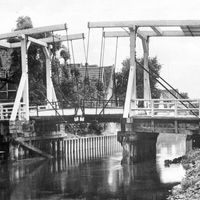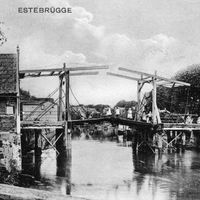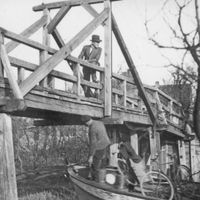53°33'58.0"N 9°36'44.4"E
The Hogendiek Bridge
Deichhufendörfer and village centres at bridges
The dykes along the Lühe are protected monuments. The villages on both sides of the Lühe: Mittelkirchen Ort, Mittelkirchen Hohenfelde, Neuenkirchen east of the river as well as Bergfried and Guderhandviertel west of the river are characteristic historic Deichhufendörfer in the Altes Land, such as Leeswig, Königreich, Hove and Moorende alongside the Este. They follow the course of the river, same as the dyke and the road. The farms with their decorative gables face the dyke, separated from each other by ditches, with the typical front gardens. Economic part
The orchards, the historic hides of the agricultural land extend behind the houses as long belts.
In contrast, Steinkirchen is a typical area that developed around the bridge, same as Estebrügge developed at the only Este Bridge downstream from Buxtehude. Craftsmen, traders and innkeepers settled down early and a village centre developed around the bridge and the church.
The Hogendiek Bridge
In 1975, the 42-metre-long and 1.5-metre-wide Hogendiek Bridge was built following the example of the old Dutch drawbridges, which are also typical for the Altes Land. This pedestrian and bicycle bridge connects Mittelkirchen and Steinkirchen. It is a fixed wooden bridge.
In 2014, the bridge was renewed by a largely identical new construction with a massive foundation. The new construction was funded by the European Union.
The Breite Brücke in Steinkirchen
There already existed a bridge in the 14 th century, but we do not know what it looked like at that time. Before that, the river had to be crossed via a ford.
Anyway, it was a fixed wooden bridge, which was so ramshackle that it had to be renewed in 1880. The boatmen and fruit traders demanded a drawbridge.
It could be opened for river traffic at any time by a bridge keeper.
In 1936, the drawbridge was flooded during a storm tide. A fixed high bridge was first planned as a replacement, however, there was strong opposition from the local population, since such a bridge would have heavily changed the appearance of the village. Down the Lühe, a barrage was built and the old bridge in the centre of the village was refurbished.
In 1945, shortly before the end of the war, the bridge was blown up by German soldiers.
Today, there is a brick bridge for car traffic in its place.




